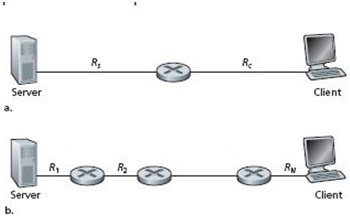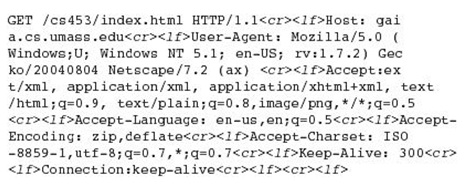Questions:
Application Layer - Networking Solution
1. This elementary problem begins to explore propagation delay and transmission delay, two central concepts in data networking. Consider two hosts, A and B, connected by a single link of rate R bps. Suppose that the two hosts are separated by m meters, and suppose the propagation speed along the link is s meters/sec. Host A is to send a packet of size L bits to Host B.
a. Express the propagation delay, dprop, in terms of m and s .
b. Determine the transmission time of the packet, dtrans, in terms of L and R .
c. Ignoring processing and queuing delays, obtain an expression for the end-to-end delay.
d. Suppose Host A begins to transmit the packet at time t = 0. At time t =dtrans, where is the last bit of the packet?
e. Suppose dprop is greater than dtrans. At time t =dtrans, where is the first bit of the packet?
f. Suppose dprop is less than dtrans. At time t =dtrans, where is the first bit of the packet?
g. Suppose s = 2.5 · 10^8, L = 120 bits, and R = 56 kbps. Find the distance m so that dprop equals dtrans.
2. Consider

Assume that we know the bottleneck link along the path from the server to the client is the first link with rate Rs bits/sec. Suppose we send a pair of packets back to back from the server to the client, and there is no other traffic on this path. Assume each packet of size L bits, and both links have the same propagation delay dprop.
a. What is the packet inter-arrival time at the destination? That is, how much time elapses from when the last bit of the first packet arrives until the last bit of the second packet arrives?
b. Now assume that the second link is the bottleneck link (i.e., Rc < Rs). Is it possible that the second packet queues at the input queue of the second link? Explain. Now suppose that the server sends the second packet T seconds after sending the first packet. How large must T be to ensure no queuing before the second link? Explain.
3. Consider the following string of ASCII characters that were captured by Wireshark when the browser sent an HTTP GET message (i.e., this is the actual content of an HTTP GET message). The characters are carriage return and line-feed characters (that is, the italicized character string in the text in attached "Problem 4.docx" represents the single carriage-return character that was contained at that point in the HTTP header). Answer the following questions, indicating where in the HTTP GET message below you find the answer.
a. What is the URL of the document requested by the browser?
b. What version of HTTP is the browser running?
c. Does the browser request a non-persistent or a persistent connection?
d. What is the IP address of the host on which the browser is running?
e. What type of browser initiates this message? Why is the browser type needed in an HTTP request message?
4. Consider a short, 10-meter link, over which a sender can transmit at a rate of 150 bits/sec in both directions. Suppose that packets containing data are 100,000 bits long, and packets containing only control (e.g., ACK or handshaking) are 200 bits long. Assume that N parallel connections each get 1/N of the link bandwidth. Now consider the HTTP protocol, and suppose that each downloaded object is 100 Kbits long, and that the initial downloaded object contains 10 referenced objects from the same sender. Would parallel downloads via parallel instances of non-persistent HTTP make sense in this case? Now consider persistent HTTP. Do you expect significant gains over the non-persistent case? Justify and explain your answer.
